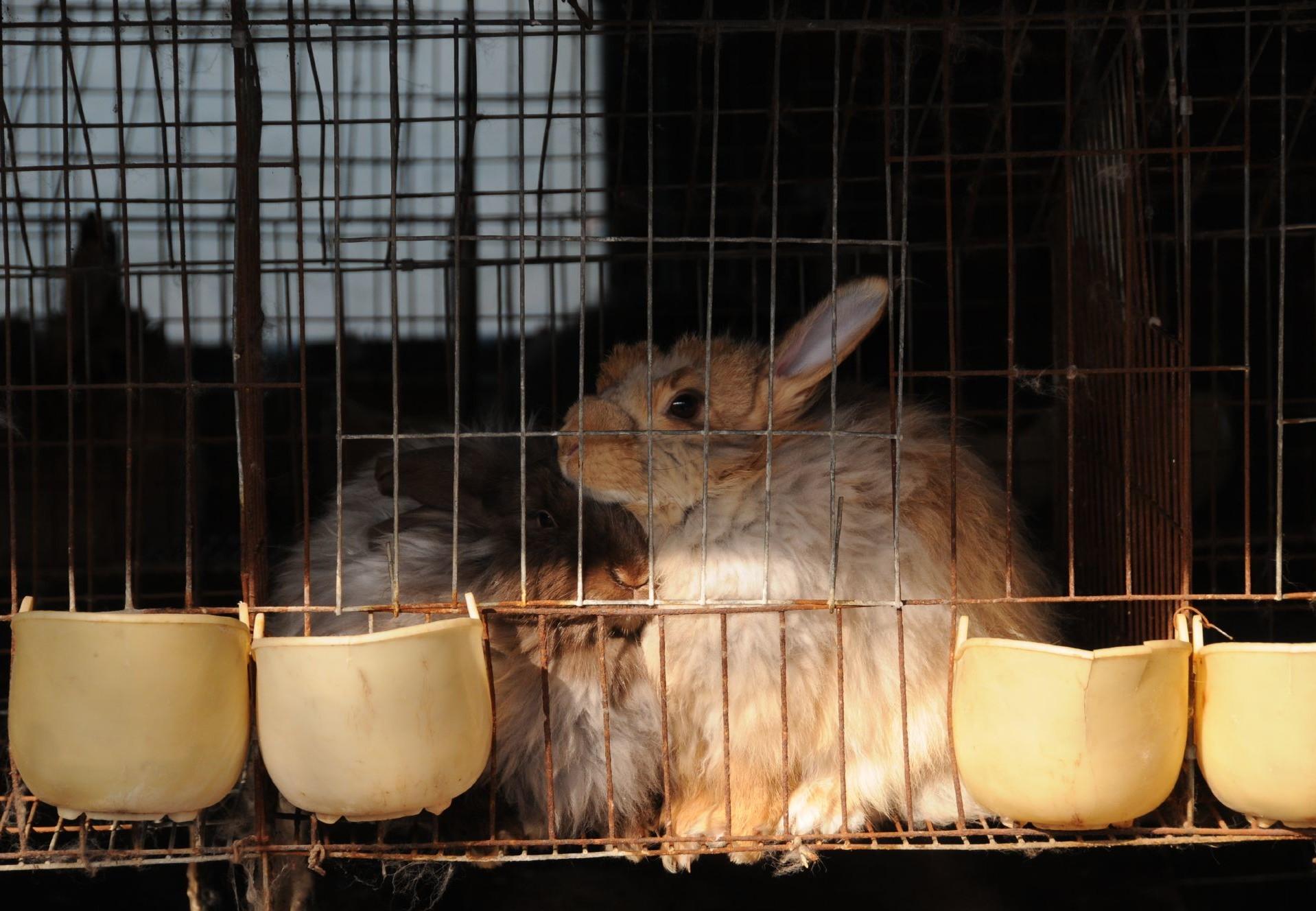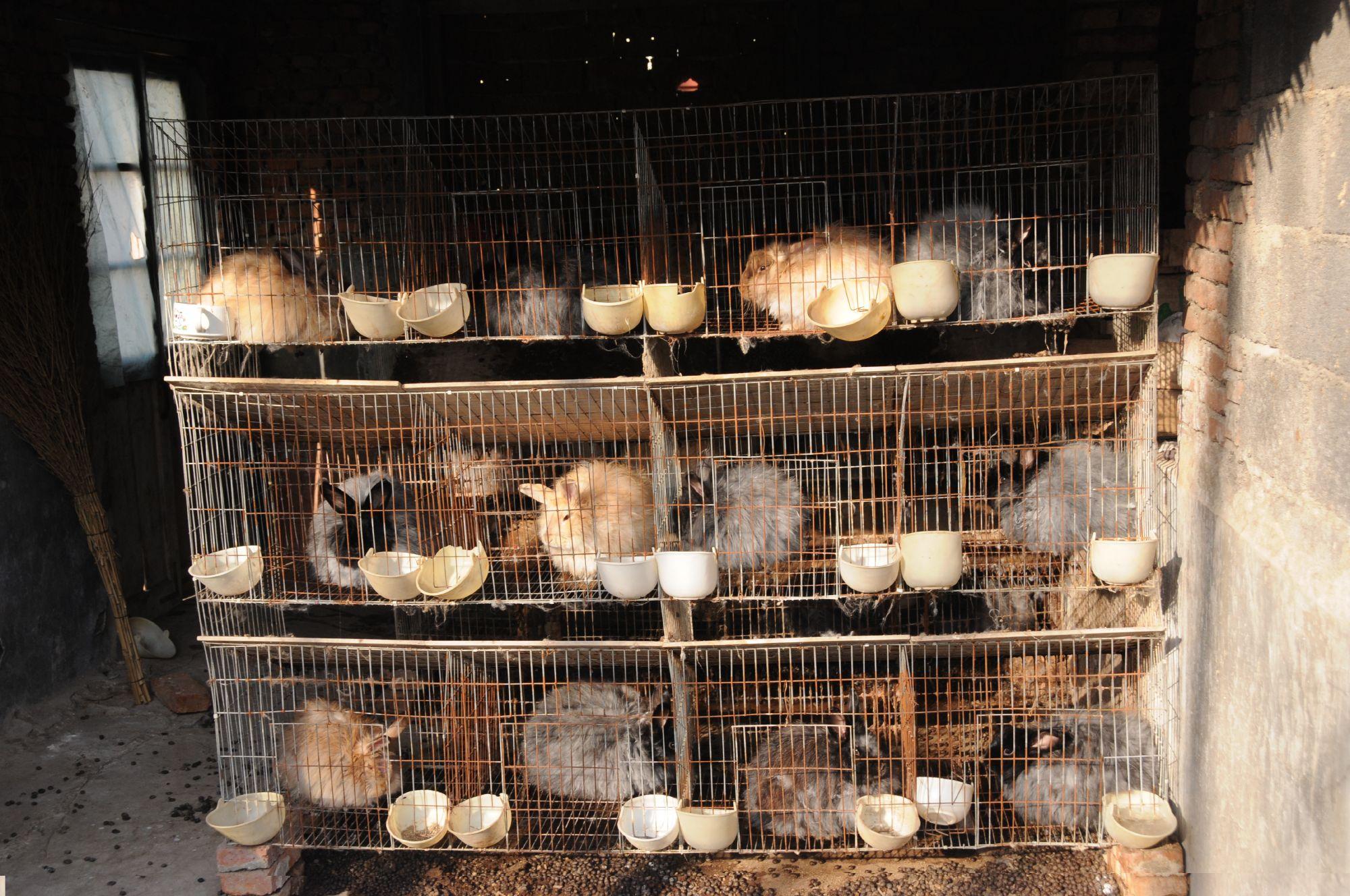
The cruel reality behind Angora Wool
How angora rabbits suffer horrendously for luxury fashion
Angora wool is a fluffy fibre that comes from the soft, thick coats of angora rabbits. It is considered a ‘luxury’ fibre, along with other wool such as cashmere, mohair and Alpaca. (Angora goats are used to produce mohair and not Angora Wool). Angora rabbits suffer tremendously during the process of collecting the wool, which is why we would always advise avoiding angora wool and shopping for animal-free alternatives. There is no cruelty-free way of keeping Angora rabbits.
Where Is Angora Wool Produced?
- The vast majority of angora wool (90%) comes from China, and other producers include Argentina, Chile, the Czech Republic and Hungary
- According to the “Discover Natural Fibres Initiative,” 2500 to 3000 tonnes of angora wool is produced each year1.
What Are the Welfare Concerns for Angora Rabbits?
Rabbits are highly social animals who seek companionship and lots of space to move around, therefore by keeping them in tiny wire mesh cages on angora farms, they are unable to carry out many natural behaviours, like gnawing on branches and scrubs, hopping or digging. The low cages also deform their spines because they cannot sit upright, and the wire mesh flooring often causes serious injuries to the paws or legs. They do not get any daylight or enrichment materials. Due to the impossibility of being able to move and to occupy themselves appropriately by foraging and exploring, behavioural disorders often develop. Abnormal, repetitive movements (stereotypies), high levels of physical aggression and gnawed or even injured ears are a daily occurrence.
Angora rabbits are intentionally bred to have fluffy wool which compromises their welfare and health. It can lead to impaired sight and eye diseases, as well as intestinal problems due to fur ingestion. To reduce their own thick underwool, they clean their fur excessively and ingest massive amounts of it. However, their stomachs are not built to digest hair, and unlike cats, rabbits are unable to vomit or regurgitate the hair. This leads to severe intestinal problems. Additionally, their ears are bred to be short, which prevents proper body thermoregulation and together with the thick fur can lead to severe heat stress of the animals. This criteria fall within the scope of breeding of defects (i.e. the breeding of animals in a way that causes them pain, abnormalities, and other health problems for the purpose of economic gain).
The process by which wool is collected from Angora rabbits causes immense suffering and stress – they are sheared around every three months using sharp cutting tools, or their fur is torn off by hand, with no pain relief provided. Shearing is a painful and stressful experience for the rabbits, as they naturally fear being handled and pinned down which is a common process in the industry, this can even lead to heart attacks due to stress.
Although the average lifespan of a rabbit in the wild is between 7-12 years, at just two years old, angora rabbits are already starting to be deemed no longer profitable, because they begin to produce less wool, and therefore, after a lifetime of misery, they are slaughtered and sold for meat.
FOUR PAWS opposes the keeping of Angora rabbits and the use of Angora wool. The keeping of Angora rabbits is inherently cruel and therefore any Angora welfare standard is unacceptable.
The keeping of the rabbits should be phased out and FOUR PAWS highly recommends the use of alternative products to angora wool.
FOUR PAWS calls for...
- a worldwide ban on all cage systems for rabbits
- an end to breeding angora rabbits with excessive hair – which compromises their welfare and health just for fashion purposes
- an end to the cruel handling of rabbits – naturally prey animals that have not established a positive relationship with the humans that they´re in contact with
- that the fashion industry stops using angora wool – there are plenty of cruelty free, sustainable alternatives of non-animal origins
- the fulfillment of basic needs of the angora rabbit, if neglected, it leads to poor welfare states and therefore to suffering, acute pain, distress, fear, and long-term negative welfare states. Basic needs are...
- Rabbits need to be able to move freely and hop around their cage where they are also able to forage, explore and rest; there should be hiding places available, along with elevated surfaces.
- Rabbits are a social species and must be kept in stable groups – they should be kept socially as it is otherwise highly detrimental to their health but with ample retreat options so that they can retreat from possible aggressive situations with conspecifics in the group
- Readily available gnawing material and a balanced diet is not essential only for the enrichment purposes, but the lack of hay and straw for food can cause severe teeth problems and consequently diarrhea and other bowel diseases that leads to death in rabbits
- A digging crate with sand and soil or other options for digging should be made available so that the animals can express their natural behavior
- Sufficient lying space with dry and soft bedding – wire mesh flooring causes serious injuries to the paws or legs which can lead to severe complications if they become infected.
- Their housing should have a good ventilation in place - poor air quality due to the high ammonia content causes breathing problems, lung diseases and purulent eyes.
- Animals should be kept in good health and receive veterinary care when and if needed, along with pain relief for injuries that inevitably occur during the shearing process.

We Need More Compassion in Fashion!
To help protect angora rabbits from this cruelty, you can avoid angora wool, and feel comfortable in the knowledge that no rabbit had to suffer in order to make your clothing.
To make your shopping choices more sustainable and animal-friendly, you can consider buying pre-loved, or secondhand clothing by purchasing from charity shops. If you do choose to buy new clothing, you can choose sustainable alternative textiles, you can find out more in our animal-friendly shopping guide.
#WearitKind

Over six billion animals are exploited for fashion and textiles every single year. Animal-free clothing is the ultimate kind and cruelty-free fashion and making carefully considered decisions is a great step towards achieving a kinder wardrobe.
There is no cruelty-free way of keeping Angora rabbits. Make a conscious choice about the clothes that you wear and #WearItKind by avoiding Angora wool products.
Source

